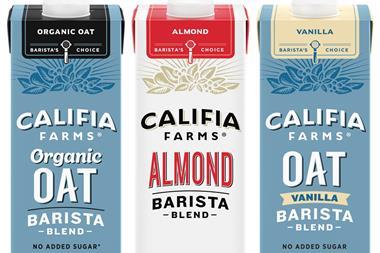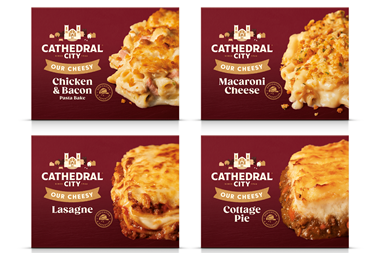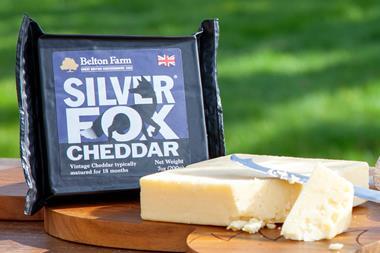>>Nigel White, secretary of the British Cheese Board, on why a traffic-light labelling system is flawed
Cheese is a natural way of preserving the protein, cream, calcium and vitamins in milk, making it one of the most nutritionally compact foods you can eat. But despite its nutritional qualities, its history and heritage, cheese is under fire.
In the pursuit of quick solutions to the obesity and diet-related diseases, cheese is in danger of being branded as a danger food by any government traffic-light system as it is high in fat and high in salt.
The British Cheese Board awaits government proposals on nutrition profiling and new ideas on food labelling being developed supposedly to make it easier for consumers to make healthy choices.
Unfortunately, cheese does not fit neatly into the good food or bad food categorisation that a traffic-light system implies. By nature of being a concentrated, nutritionally dense food, it is high in many key nutrients (of which fat is one) on a per 100g basis and hence would be categorised as a red on both fat and salt.
But such a simplified labelling system ignores portion size and the fact that cheese also delivers other key nutrients - particularly protein, calcium and Vitamin A.
Taking average portion size first, the average serving size for a hard cheese such as Cheddar is 40g. To compare food products on the basis of nutrients per 100g while ignoring portion size is ludicrous and misleading. And yet that is the basis of government policy on nutrition. As a result, its advice is that cheese should be eaten in moderation - although what this means is far from clear. It advises that schools should be reducing the amount offered on lunchtime menus and parents should reduce the amount in packed lunches.
Average consumption of all cheese in the UK (including fromage frais and cottage cheese) is just 30g per person per day. No doubt the same officials would be very concerned if faced with the level of cheese usage found in the rest of the EU. There, the average consumption is over 50g per person per day (while France and Greece manage around 65g). Yet the UK has higher obesity rates, especially among its young people, than in these other EU countries. In cheese consumption terms, the UK is in division three, along with Spain, Portugal and Ireland.
If we look at what British children are eating, they each get through an average of about 15g per day and that ignores the 20%
of children who eat no cheese. The diets of young people fail to deliver the Reference Nutrient Intake of calcium in over 40% of cases and fail to deliver the RNI for Vitamin A in over 60% of cases.
A matchbox-sized portion of Cheddar (30g) delivers 40% of the recommended daily amount of calcium for a seven to nine-year-old child, 23% of the RNI for Vitamin A, 28% of the protein (plus healthy contributions of other essential vitamins and minerals) but only 6.3% of the energy. The same piece of cheese has fewer calories, fat and salt than the same weight of many of the snacks found in school lunchboxes.
Cheese is not the cause of obesity nor is it the cause of bad diets or unhealthy lifestyles. Rather, as part of a healthy diet, cheese should be part of the solution. The government has an important role to play in helping consumers make informed choices about the food they eat. But the current muddled thinking will, in my view, cause even more confusion.
Many people do not understand nutrition terms because they have not been taught them at school. As far as cheese is concerned, they struggle to name more than a handful of cheeses and they overestimate the fat content of cheese by a considerable degree. As an industry, we have not done a good enough job over the years in helping consumers understand cheese.
Through our members and associate members, we are putting in place a long-term education programme. We can only hope the government follows a similar factual and science-based approach towards the development of its food nutrition policy.
Cheese is a natural way of preserving the protein, cream, calcium and vitamins in milk, making it one of the most nutritionally compact foods you can eat. But despite its nutritional qualities, its history and heritage, cheese is under fire.
In the pursuit of quick solutions to the obesity and diet-related diseases, cheese is in danger of being branded as a danger food by any government traffic-light system as it is high in fat and high in salt.
The British Cheese Board awaits government proposals on nutrition profiling and new ideas on food labelling being developed supposedly to make it easier for consumers to make healthy choices.
Unfortunately, cheese does not fit neatly into the good food or bad food categorisation that a traffic-light system implies. By nature of being a concentrated, nutritionally dense food, it is high in many key nutrients (of which fat is one) on a per 100g basis and hence would be categorised as a red on both fat and salt.
But such a simplified labelling system ignores portion size and the fact that cheese also delivers other key nutrients - particularly protein, calcium and Vitamin A.
Taking average portion size first, the average serving size for a hard cheese such as Cheddar is 40g. To compare food products on the basis of nutrients per 100g while ignoring portion size is ludicrous and misleading. And yet that is the basis of government policy on nutrition. As a result, its advice is that cheese should be eaten in moderation - although what this means is far from clear. It advises that schools should be reducing the amount offered on lunchtime menus and parents should reduce the amount in packed lunches.
Average consumption of all cheese in the UK (including fromage frais and cottage cheese) is just 30g per person per day. No doubt the same officials would be very concerned if faced with the level of cheese usage found in the rest of the EU. There, the average consumption is over 50g per person per day (while France and Greece manage around 65g). Yet the UK has higher obesity rates, especially among its young people, than in these other EU countries. In cheese consumption terms, the UK is in division three, along with Spain, Portugal and Ireland.
If we look at what British children are eating, they each get through an average of about 15g per day and that ignores the 20%
of children who eat no cheese. The diets of young people fail to deliver the Reference Nutrient Intake of calcium in over 40% of cases and fail to deliver the RNI for Vitamin A in over 60% of cases.
A matchbox-sized portion of Cheddar (30g) delivers 40% of the recommended daily amount of calcium for a seven to nine-year-old child, 23% of the RNI for Vitamin A, 28% of the protein (plus healthy contributions of other essential vitamins and minerals) but only 6.3% of the energy. The same piece of cheese has fewer calories, fat and salt than the same weight of many of the snacks found in school lunchboxes.
Cheese is not the cause of obesity nor is it the cause of bad diets or unhealthy lifestyles. Rather, as part of a healthy diet, cheese should be part of the solution. The government has an important role to play in helping consumers make informed choices about the food they eat. But the current muddled thinking will, in my view, cause even more confusion.
Many people do not understand nutrition terms because they have not been taught them at school. As far as cheese is concerned, they struggle to name more than a handful of cheeses and they overestimate the fat content of cheese by a considerable degree. As an industry, we have not done a good enough job over the years in helping consumers understand cheese.
Through our members and associate members, we are putting in place a long-term education programme. We can only hope the government follows a similar factual and science-based approach towards the development of its food nutrition policy.








No comments yet